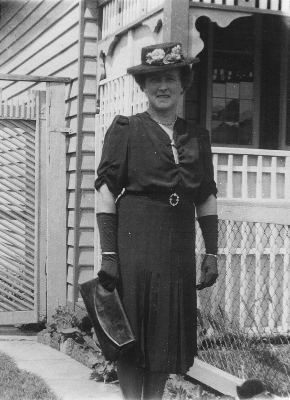Quilt No.443DC - Dorothy Cawood

1850 x 1500mm
The quilt was made by Francis Jane McElhinney 1896-1965 in Londonderry Ireland pre 1926. One of 2 quilts brought to Australia as family luggage on the Barrabool in 1926. Passed by maternal descent to the present owner, Dorothy Cawood, who is the grand-daughter of Francis. The quilts were used in Ireland and Australia for extra warmth when needed. More recently they were used under the wire mattress, as dog blankets, as moving blankets to protect furniture and as drop sheets for painting. They were stored in a back shed but are now valued and stored in the owner's house. They are not now used.
"My grandmother Francis Jane McElhinney (nee Patterson) was born on the 15.4.1896 at Milford, Letterkenny, Eire and died on the 22.1.1965 at Melbourne. Francis and her husband Robert lived in a 2 storey house at No.1 Sydney Terrace, Great James Street, Londonderry Ire, where Martha, (my mother) and Francis were born. A third daughter, Laura was born in Australia in 1926 soon after their arrival.
My grandfather was a motor mechanic for Rover and my grandmother was a secretary/typist for a law company. I have a small Pitman's Shorthand Pocket Dictionary presented to her on passing her examinations dated July 1912. My mother also tells of her parents taking in borders to supplement their income.
The reason for leaving Ireland for Australia in 1926, was the opportunity for a better way of life.
The quilts I have were used for bedding both here and in Ireland. My Mother used them for extra warmth when needed, but I can remember them being under the mattress on my bed, whether it was for easy storage when not is use, or it kept the draught from coming up through the wire base, then they ended up in our garage.
Their belongings came to Australia in trunks, one of which I keep my embroidery supplies. As you will see from a copy of goods and chattels sold at auction* before the family sailed a lot of quilts were left behind, perhaps too bulky or heavy to transport, or maybe they thought they would not be needed in a warm country like Australia. My grandmother did not value the quilts, they were a purely functional household item, although I wonder why these 2 were kept. I also have some linen pillow shams with a crochet edge and handmade buttons, that were also used on their beds. The family moved into a house (1926 or 1927) at 71 Benjamin Street Sunshine (not far from where I live) until the 3 girls were married and their parents passed away. My grandmother taught her 3 daughters to mend, darn, crochet, knit and of course do "fancywork" which mum remembers would be done after the household chores and music practice. Mum recalls being taught to darn her socks at the age of 6 before she came to Australia."
[Dorothy Cawood 13.1.1999]
* The auction sale notice lists 3 "P.Work Quilt" and 6 "Quilt" at prices ranging from 4 shillings and threepence to one shilling. ED.



Related Quilts:
2615 x 2280mm
2650 x 1573mm
2058 x 1829mm
940 x 915mm
2440 x 1720mm






